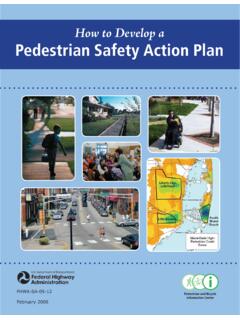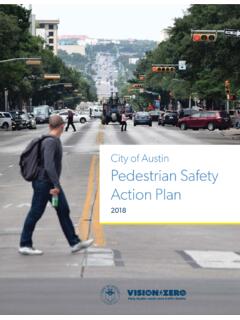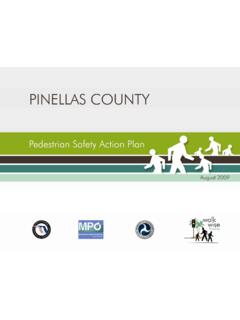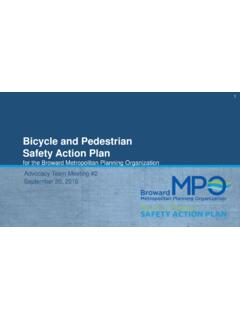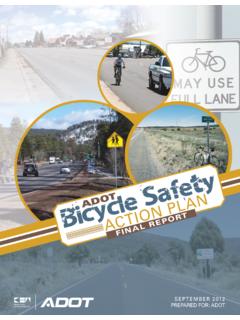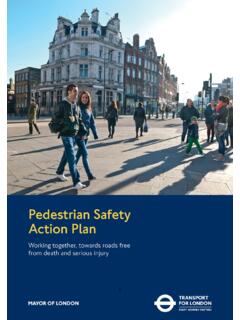Transcription of Staten Island - Welcome to NYC.gov | City of New York
1 PROFILEiStaten Island pedestrian safety action Plan2015 pedestrian safety action PlanStaten IslandiiVision ZeroPROFILEiiStaten Island pedestrian safety action plan Letter from the MayorLetter from the CommissionersExecutive SummaryWhy a pedestrian plan ?About This PlanNorth Shore Case StudySection 1: Staten Island Borough Profile Case Study: The North ShoreSection 2: Priority Corridors, Intersections, and AreasSection 3: Community Dialogue and InputSection 4: Borough action PlanAppendix A: Priority Corridors Fatality and Severe Injury HistoryAppendix B: Priority Intersections Fatality and Severe Injury HistoryTable of Contentsiiiiivviviii11015233344ix45iiLet ter from the MayorDear Friends, Every life in New York City is precious. It is our responsibility, as residents, workers, and visitors of this great city, to save every life we can. This administration made Vision Zero, and the elimination of traffic fatalities, a priority from day one. The fundamental message of Vision Zero is that death and injury on city streets is not acceptable, and that we will no longer regard severe crashes as inevitable.
2 This is reflected in the Vision Zero action plan that set out directives for city agencies, including the New York City Department of Transportation, the New York Police Department, and the Taxi and Limousine Commission. Traffic crashes can claim the lives of anyone in New York City. They kill people who drive and those who bike, but overwhelmingly, the deadly toll is highest for pedestrians. This plan acknowledges this injustice toward pedestrians and the synergies that can be realized by improving pedestrian safety for overall traffic safety , well-being, and urban livability. In close partnership with our community and advocacy groups and our families and friends of lost loved ones, we are dedicating ourselves to ending this epidemic. NYCDOT and NYPD representatives were out in our communities this past summer listening to us, preparing us for the changes that are taking place, and explaining how to be more conscious and conscientious street users. Meanwhile, we have been working to improve our collection and understanding of the data behind traffic fatalities, where the hot spots are, and what can be done to erase them from the map.
3 The pedestrian safety action Plans help us do just that. Our recent success in reducing the citywide speed limit to 25 MPH, redesigning intersections and corridors and increasing enforcement of the most dangerous driving behaviors are just some of the ways we are making our city s streets safer. The pedestrian safety action Plans are the next step in achieving Vision Zero in your community. New Yorkers deserve to feel safe on their streets. Thank you for your input into this process, together we will save de Blasio MayorStaten Island pedestrian safety action PlaniiVision ZeroPROFILEiiStaten Island pedestrian safety action plan iiRECOMMENDATIONS iiiiiiiiLetter from the CommissionersDear fellow New Yorkers,We are proud to bring you the Vision Zero Borough pedestrian safety action Plans. These documents represent the highly detailed combination of DOT and NYPD crash data and analysis, over 10,000 online comments via the Vision Zero Public Input Map, and nine public pedestrian safety workshops across the five boroughs.
4 These borough-specific plans outline our current progress and help define the next phase of Vision first year of Vision Zero in New York City proved successful; after two years of increases, the city experienced the lowest number of pedestrian fatalities since record keeping began in 1910. In 2014, the city lowered its speed limit to 25 MPH, completed over 50 major safety engineering projects, and expanded traffic enforcement dramatically, with speeding summons increasing 42% and failure-to-yield summons increasing 126%. DOT and NYPD partnered to form the Vision Zero Street Team, launching a series of two-phase, two-week campaigns focused on pedestrian safety . The first phase of the campaigns included distributing traffic safety literature to the public at collision-prone locations to promote traffic safety . These weeklong efforts to educate the public were then followed by a week of focused, safety -related enforcement to address persistent the Borough pedestrian safety action Plans, we will build on this success and continue to improve the way we monitor, design, and govern our streets.
5 The Borough Priority Maps will serve as a guide for our agencies to systematically improve streets with the highest rates of pedestrian fatality and severe injury. By coordinating our planning, engineering, education, and enforcement efforts in these areas, DOT and NYPD can make significant progress toward the vision of eliminating pedestrian fatalities across the five the past 30 years, we have made tremendous progress in traffic safety . We have seen large decreases in the number of fatal crashes, including fatal pedestrian crashes. Motor vehicles, however, continue to seriously injure or kill a New Yorker about every two hours. Each of these tragedies compels us to come together and deliver a safer future for our city. There is plenty of work still ahead of Trottenberg William BrattonDOT Commissioner NYPD CommissionerStaten Island pedestrian safety action plan pedestrian fatalities on Staten Island have risen by 11% in the past three decades Staten Island s pedestrian fatality rate is fatalities per 100,000 residents, the lowest of the five boroughs Where: Staten Island s pedestrian fatalities and severe injuries are most heavily concentrated on the North and East Shores When: Afternoon and evening hours (3-9pm) hours account for 80% of Staten Island pedestrian fatalities, as opposed to 31% citywide Who: Staten Island seniors account for 25% of the borough s pedestrian fatalities, versus 35% citywide What: Passenger vehicles are involved in nine out of ten pedestrian fatalities on Staten Island , compared to 68% citywide How.
6 Dangerous driver choices are the primary cause or a contributing factor in 67% of pedestrian fatalities on Staten Islandiv Staten Island pedestrian safety action PlanFindingsStaten Island Borough ProfileExecutive SummaryPriority Corridors, Intersections, and AreasShare ofBoroughShare of Ped KSI*TotalPed KSI% of TotalPed KSI% of Total PedFatalities% ofBoroughBoroughPriority CorridorsPriority IntersectionsPriority AreasCombined Total16 corridors (53 miles)837 miles12923854%40%5%33%55%17%50%238238401 1917272%59 sq miles8,011intersections17 sq miles6%1%13%NEW JERSEYNEW JERSEYW olfes Pond ParkBloomingdale ParkBlue Heron Park PreserveGreat Kills ParkWillowbrookParkSilver LakeParkLatouretteParkFreshkillsParkConf erence House ParkFDR BeachPriority IntersectionsPriority CorridorsPriority AreasStaten Island Priority Map*Ped KSI: Pedestrians Killed or Severely InjuredvStaten Island pedestrian safety action PlanCommunity Dialogue and Input 635 Staten Island pedestrian safety issues were shared and mapped digitally Speeding (26%) and failure to yield (20%)
7 Were the most frequently cited issues 57% of workshop attendees viewed wide arterial streets as the most important areas for pedestrian safety improvements 51% of issues shared fall outside of the Priority Corridors, Intersections, and AreasAction PlanEngineering and Planning Implement at least 50 Vision Zero safety engineering improvements annually at Priority Corridors, Intersections, and Areas citywide, informed by community input at project locations Significantly expand exclusive pedestrian crossing time on all Staten Island Priority Corridors by the end of 2017 Add exclusive pedestrian crossing time to all feasible Staten Island Priority Intersections by the end of 2017 Modify signal timing to reduce off-peak speeding on all feasible Staten Island Priority Corridors by the end of 2017 Install expanded speed limit signage on all Staten Island Priority Corridors in 2015 Drive community input and engagement at Staten Island Priority Corridors, Intersections, and Areas Coordinate with MTA to ensure bus operations contribute to a safe pedestrian environment Expand a bicycle network in Staten Island that improves safety for all road users Proactively design for pedestrian safety in high-growth areas on Staten Island including locations in the Housing New York planEnforcement Implement the majority of speed cameras at Priority Corridors.
8 Intersections, and Areas Focus enforcement and deploy dedicated resources to Staten Island NYPD precincts that overlap substantially with Priority Areas Prioritize targeted enforcement at Staten Island Priority Corridors, Intersections, and Areas annually Focus failure-to-yield and speeding enforcement in the afternoon and evening, when 80% of pedestrian fatalities occurEducation and Awareness Campaigns Target child and senior safety education at Staten Island Priority Corridors and Priority Areas Target Street Team outreach at Staten Island Priority Corridors, Intersections, and Areas viStaten Island pedestrian safety action PlanWhy a pedestrian plan ? pedestrian fatalities have grown as a share of all traffic fatalities Vision Zero seeks to eliminate all deaths from traffic crashes regardless of whether on foot, bicycle, or inside a motor vehicle. This Borough plan is one of 63 Vision Zero initiatives advancing that goal for all street users. Despite aggressive pedestrian -oriented street re-engineering between 2007 and 2013, citywide pedestrian fatalities have not declined.
9 In fact, they increased in 2012 and 2013 while fatalities to other street users fell. Comparing the periods of 2005-2007 to 2011-2013, pedestrian fatalities actually rose by 2% while fatalities to all other users fell by 24%. At the same time, the pedestrian share of overall fatalities rose from 51% to 58%. Nationwide, pedestrians make up just 14% of all traffic In Staten Island , pedestrians are 48% of all fatalities. The challenge of an aging cityAdditionally, the baby-boom generation has begun to hit retirement age and New York City will soon experience a rapid growth of its senior citizen population. The city s seniors walk much more than those elsewhere in the United States, and their pedestrian fatality rate is four times that of younger New Yorkers. Without a focused strategy on pedestrian safety to address this need, New York City could potentially see an alarming rise in pedestrian fatalities. Between 2007 and 2013 pedestrian fatalities grew from 51% of all traffic fatalities to 58%Fatalities by Mode: Staten Island Compared to NYC, 2011-2013 Average, RoundedAll NYC FatalitiesStaten Island FatalitiesBicyclistsPedestriansMotorcycl ists58%48%6%9%22%41%2 %14% Motor Vehicle OccupantsPedestrianMotorcyclistsMotor Vehicle Occupants1577 Bicyclists170371616 All NYCS taten IslandTotal27214viiStaten Island pedestrian safety action PlanviiPedestrian focus improves safety for all usersStreet design based around pedestrian safety is also proven to make travel safer for other street users, including bicyclists and motor vehicle occupants.
10 Slower vehicle speeds, less chaotic, better organized traffic, and narrower vehicle lanes make streets safer (and easier to use) for cyclists. A pedestrian oriented project on Delancey Street in Manhattan contributed to a 20% reduction in injuries to cyclists. Similarly, projects and programs aimed at improving safety for pedestrians often improve motor vehicle safety as well. The pedestrian focused re-design of the Madison Square/Flatiron area contributed to a 46% reduction in injuries among motor vehicle occupants. The areas of New York City that accounted for 71% of pedestrians killed or severely injured (KSI) also accounted for 66% of cyclist KSI. safety interventions at these locations can address safety concerns for both groups of street comprehensive strategy addressing all modesNew York City will need to go beyond the actions in this plan to address all traffic fatalities, particularly for vulnerable road users: the pedestrians, bicyclists, and motorcyclists that use the streets without the protection of a closed vehicle.










